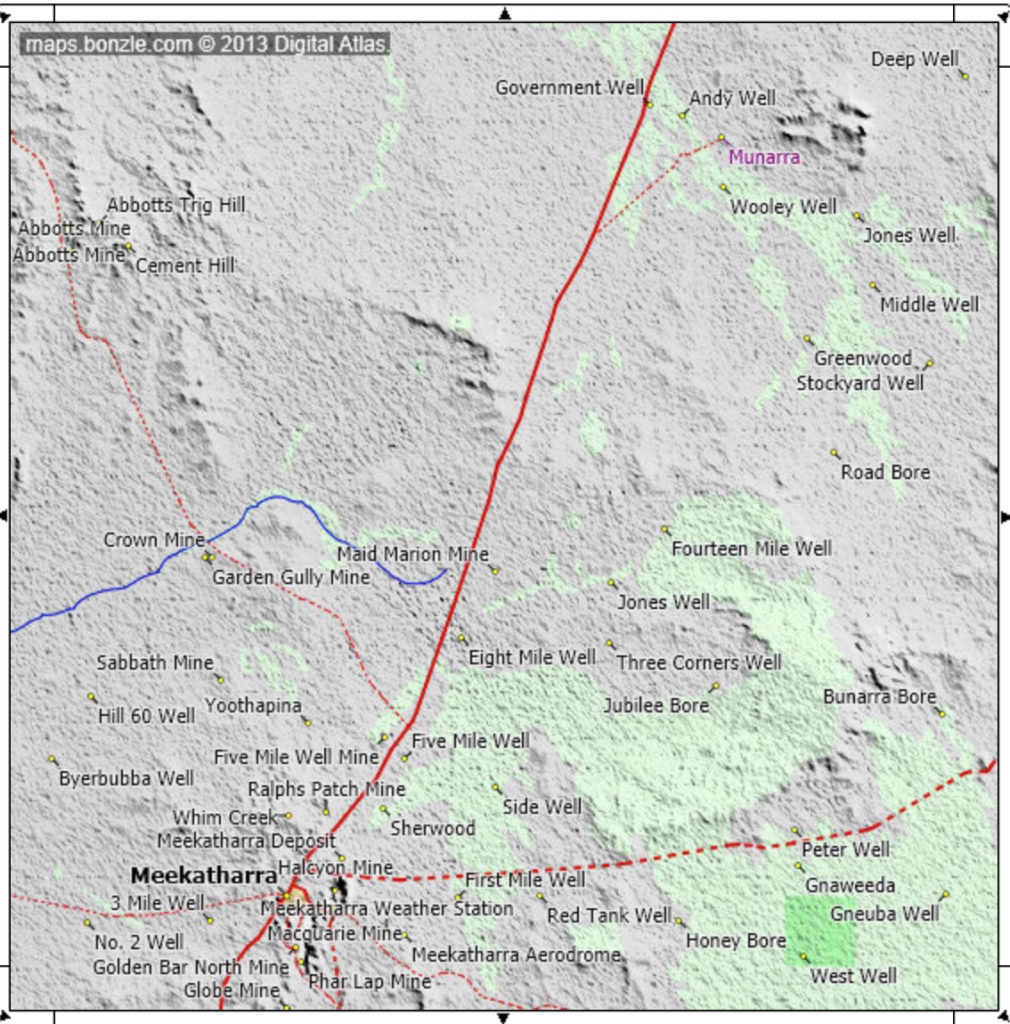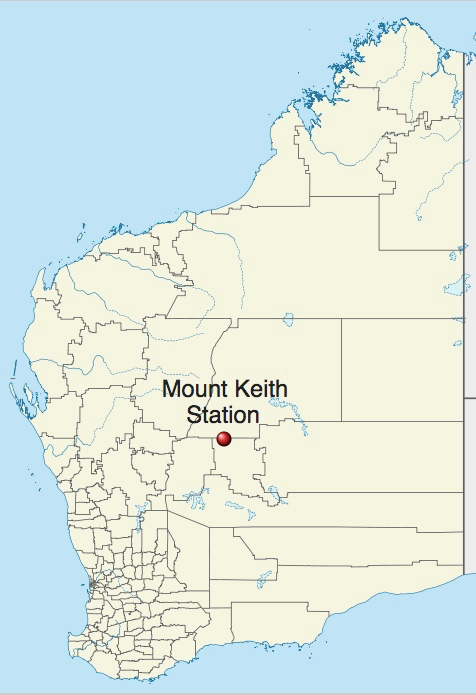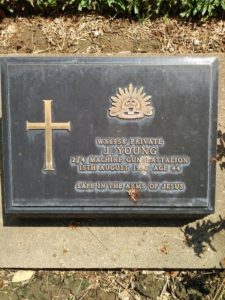The Soldier's Details

- Surname:
- Young
- First Name:
- John
- Nick Name:
- Jock
- Rank:
- Private
- Regimental #:
- WX6958
- Company:
- 'A' Company, No. 4 Platoon
- Enlisted:
- 30.07.1940
- DOB:
- 19.07.1901
- Place of Birth:
- Glasgow, Scotland
- Father's Name:
- John Young
- Mothers's Name:
- Mary Young
- Religion:
- Presbyterian
- Pre-war Occupation:
- Labourer
- Memorial:
- Kanchanburi War Cemetery, Plot 8, Row G, Grave 72, Age 46.
- Singapore:
- Selarang Camp and Barracks Changi
- Force:
- 'D' Force Thailand, S Battalion
- Camps Thailand:
- Tarsau, Konyu II, Chungkai, Nacompaton.
- POW#:
- 4/6856 & 8863
- Cause of Death:
- Beri-Beri, Dysentery, Malaria and Odema
- Place of Death:
- Nacompaton
- Date of Death:
- 15.08.1945
General Description
John Young served in WW1 in Britain. He enlisted 7 December 1917 serving with Royal Flying Corps as fitter-armourer with No.’s 176 and 274 Squadrons.
At end of WW1 Young served with Palestine Brigade HQ then 111 Squadron and later renumbered as 14 Squadron achieving rank of AC 1st Class. During this time Jock would live in a very different climate. He would also meet Australians. (please see below ***)
1921 UK absentee voters list – John Young Jr 18 East Crawford St, AC/2 RAF 157766
He was discharged in July 1926 having experienced first hand the formation of Royal Air Force.
John’s Service No. was 157766 (a high number because the fledgling Air Force was at that time part of British Army).
_________
Jock’s parents, also John Young and wife Mary were living 21 Slatefield Street, Glasgow in 1901 Census with their 12 month old daughter Margaret (sister to Jock).
According to family historians – Jock’s grandmother stated in a document 14 Aug 1885 that John Young (father to Jock) was then serving with the Royal Marines. Prior to Jock’s grandmother’s death in May 1898 she stated in a document her son John Young was no longer with the Marines and working as a Storeman, James Wallace & Son, Agricultural Engineers, Graham Street, Glasgow.
Soon after his RAF discharge in England in July 1926, Jock emigrated to WA on the recommendation of his cousin, also named ‘John Young’ who had been residing in WA for several decades. Jock arrived 29 September1926 from London on ‘Benalla.’ He was 25 years old and his occupation was recorded as general farm labourer.
Jock worked on remote cattle/sheep stations in the north west prior to enlisting July 1940. He later joined ‘A’ Company No. 4 Platoon.

Above: Munarra Sheep Station 40 km north of Meekathara. In 1921 it was described as 325,000 acres with 7,000 sheep and had been purchased by J.H. Church. (When Jock was working at Munarra it was owned by Brookes Brothers, Malcolm and Hector. Hector went on to purchase further stations in WA and SA.)
According to Western Australia Electoral Rolls for 1936, 1937 and 1943 Jock was at Munarra Station, Meekathara (40 kms north) working as a station Hand. Earlier in 1931 Electoral Roll he was recorded at Mt Keith Station, Kalgoorlie working as a station hand. This sheep station is approx. 72 km north of Leinster and 81 km south of Wiluna. We believe Jock was previously working as a farm hand at ‘Golden Grove’ Mt. Kokeby, Beverley.
Jock apparently injured his hand whilst working – losing a finger or thumb. His relative Peter Stevenson wonders how Jock managed to successfully enlist in Australia?

Jock’s cousin John Young had served with AIF’s 16th Battalion WW1. He was first sent to Gallipoli and later served in France. He was taken POW at Bullecourt during the horrific battle which resulted in terrible loss of lives in 1917. Initially cousin John deserted the Australian Navy in Jan 1915. He assumed his mother’s maiden surname and managed to enlist with AIF.
Much of the Young family history has been generously provided from Canada, from Mr Peter Stevenson whose late grandmother Agnes Young was a first cousin to Jock Young.
Thank you Peter.
It was also Peter Stevenson who initially provided Jock Young’s information in response to Murray Ewen’s media request for information for his book.
_________
Jock Young died at Nacompaton,Thailand on the last day of WW2 15th August 1945 aged 46 years. He was seriously ill with beri beri dysentery, malaria and odema. He enlisted 30 July 1940 giving his birth date as 1901 because the age limit was 40 years. He was in fact born 19 Jul 1899.
He is also the last man listed on 2/4th Machine Gun Battalion’s Honour Roll.
Plaque at Kanchanburi War Cemetery, Plot 8, Row G, Grave 72


Below: this death notice is from cousin John Young and his wife Mary of Mt. Hawthorn.

_________
John was selected in Singapore to work on the Burma-Thai Railway with ‘D’ Force S Battalion This party included a very large number of 2/4th men, they travelled in crowded small rail trucks from Singapore to Thailand for 4 days.
Their first major work site was part of Hellfire Pass – Konyu II having previously worked about 4-6 weeks at Tarsau – clearing the land in preparation for the rail link.
At Konyu II the men quickly learned life at Changi and Tarsau had been easy – almost a picnic! They now worked long hours, minimal food, no medicines, without shoes wearing mostly ‘Jap Happys’ and nothing else. The conditions working at Hellfire Pass cutting were as such – very hot and considerble glare working in the cutting, no protection from pieces of rock flint flying the air causing wounds which quickly became ulcerated, beating from their guards with rifle butts for little or no reason; worked in a two-man team using ‘hammer and tap’ – one man holding the ‘hammer’ and the other holding the ‘tap’ to create an opening for explosives to blow the rock. The next two men would load the rubble by hand into a basket to be carried away. The tools were hand held, usually old and in poor condition. No machines or even wheel-barrows!
Cholera was reported at Konyu II followed by deaths. Their doctor was Phill Millard, whom the men thought very highly of.
Read further about Phil Millard.
As there are no records, we cannot be certain about where John Young went after Konyu II – as the men went to different camps within the area. These included Hintok and Kinsaiyok.
Jock was evacuated sick to Chungkai Hospital Camp from Hellfire Pass Cutting. He obviously recovered, was sent with work parties elsewhere in Thailand. Once again there are no records.
The Railway was completed about end of 1943 after which all the POWs were concentrated at 4 or 5 large camps from where the ‘fit’ men were selected to work in Japan, the rest for parties to work around Thailand. Many of the sick recovered with better conditions now that Speedo was over and food had improved a little. The Hospital Camps did have access to medicines mostly purchased with their own money.
Jock must have been evacuated to Nacompaton Hospital Camp, Thailand where he died August 1945, just before the end of war. Nacompaton was a large Hospital Camp with better conditions than those on the Rail line. Jock had served in two World Wars – for England in WW1 and Australia in WW2 and his luck had run out.
Below is from Museums Victoria
***
“The British Royal Flying Corps (RFC), the forerunner of the Royal Air Force (RAF), was initially created in 1912 as a means of observation for the British military and it was primarily for reconnaissance that they were deployed during the war.
The Australian Flying Corps (AFC), the forerunner of the Royal Australian Air Force (RAAF), was formed two years later in 1914 at Point Cook and was affiliated with the Australian Imperial Force (AIF). Following the outbreak of World War I, however, the Australian Flying Corps primarily flew under the operational control of the Royal Flying Corps.
No. 1 Australian Squadron, which left for the Middle East in March 1916, was duly renamed 67th Squadron RFC in September 1916 by the Royal Flying Corps and retained this designation until February 1918. Although the records kept by the squadron retain their Australian designation of No. 1 Australian Squadron. On 1 April 1918 the RFC became the RAF.
Other British squadrons, including No. 14, No. 17, No. 111, No. 144 & No.145 were deployed in the Middle East forming the Palestine Brigade. No. 17 was later transferred to Salonika. No. 14 Squadron continued to fly reconnaissance and ground attack sorties along with No. 1 Australian Squadron, until the end of the war when both squadrons were disbanded.
The Australian Flying Corps and the Royal Flying Corps had many more squadrons active on the Western Front in France.”
Camp Locations:
- Selarang Barracks Changi - Singapore
- Selarang Camp Changi - Singapore
- Chungkai, 60k - Thailand
- Kanu II, 152.30k - Thailand




